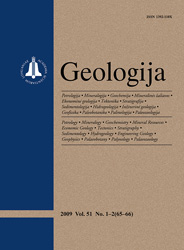Geologija / Geology
WHAT?
 ISSN 1392-110X ISSN 2029-056X (online) |
2008 m. Nr. 4 Sedimentation and near-bottom currents in the South-Western Atlantic
The aims of the paper are: 1) to study the bottom relief and Late Quaternary bottom sediments of the South-Western Atlantic from the Amazon cone to the Vema Channel and Rio Grande Rise, and 2) to reconstruct recent and palaeo-Antarctic near-bottom currents (AABW). For this purpose, we used three main Parasound seismic profiles: 30 cores (up to 500 cm in length), the nanoplankton stratigraphy of 9 cores from the Brazilian lithological profile (along 24 °W), and literature sources. No soft sedimentes were found in the Vema channel; the bottom of the channel is acoustically “hard”. Our geological data confirm that AABW flows mainly through this channel. The velocity of this flow should be higher than 100 cm. s–1. Only this strong current is able to rewash not only soft Holocene sediments, but also consolidated Quaternary deposits. Soft layered sediments occur at a depth less than 4200 m in the Hunter channel. Consequently, the AABW is able to flow from the Argentine Basin to the Brazil Basin only at a depth of more than 4200 m in this channel. Brown red clay or yellowish gray miopelagic clay prevail in the Brazil Deep. The age of red clay in the cores is different: Early or Late Pleistocene, or Holocene. Clay was rewashed and re-deposited in many areas of the deep. This means that the hydrodynamics sometimes was very active at a depth of 4000–5000 m in the Brazil Deep. The presence of conturite and turbidite interlayers in the red clay of the S. America continental base confirms the occurrence of a strong jet of the AABW (Deep Western Boundary current – DWBC) here. Antarctic and other diatoms were brought by AABW from Antarctica up to 10–5 °S. An unusual Pleistocene Ethmodiscus rex ooze was discovered at the latitude of 20 °S. Our data confirm the occurrence in the area between 10–5 °S of two mid-oceanic channels, one of them (EMOC) being located on a large sedimentary swell. The AABW in the cross-section from the Amazon River to the MAR flows through the Nara (depth 4640–4660 m) plain. This flow was confirmed by hydrochemical data. The AABW started to appear in the Rio Grande Rise region, about 50–30 mill. years. Cyclic events of glaciation and interglacial transitions throughout the Miocene–Pleistocene is a mechanism that caused the AABW currents to become more intensive or passive, with the result that the intensity of the influx of these waters from the Brazilian Basin into the Guiana Basin also changed from strong to weak. Keywords: South-western Atlantic, Brazil Basin, near-bottom currents, sediments, palaeoreconstruction |
Issues:
2011 - Vol.53 No. 1, No. 2, No. 3 2010 - Vol.52 No. 1-4 2009 - Vol.51 No. 1-2, No. 3-4 2008 - Vol.50 No. 1, No. 2, No. 3, No. 4, No. Priedas 2007 No. 1, No. 2, No. 3, No. 4 2006 No. 1, No. 2, No. 3, No. 4 2005 No. 1, No. 2, No. 3, No. 4 2004 No. 1, No. 2, No. 3, No. 4 2003 No. 1, No. 2, No. 3, No. 4 2002 No. 1, No. 2, No. 3, No. 4 2001 No. 1, No. 2, No. 3, No. 4 |